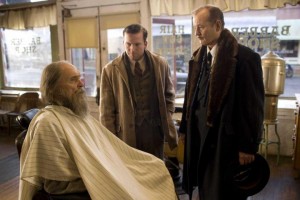By Robert Sims, Special to TheMovieKit.com
 Felix Bush doesn’t fear being late to his own funeral — because he plans to be there. Just not in the casket.
Felix Bush doesn’t fear being late to his own funeral — because he plans to be there. Just not in the casket.
In the bittersweet 1930s dramedy Get Low, Robert Duvall’s cantankerous hermit ends 40 years of seclusion when he decides to make his funeral arrangements. He wants to attend his funeral party ostentatiously to hear the strange stories that people have spread about him over the years. Bill Murray is the funeral director responsible for getting the townsfolk to the funeral, Friday Night Lights’ Lucas Black is his assistant, and Sissy Spacek is a woman from Duvall’s distance past.
Duvall, Murray and Spacek joined director Aaron Schneider and screenwriter Chris Provenzano to discuss Get Low following its SXSW screening.
Step 1: Cast Duvall and the rest will follow
Robert Duvall: “It was a very unique piece, a Southern tale. My wife and I were on vacation near her family in northern Argentina. I just sat on the veranda of this rustic hotel overlooking the Anders and I just went over the part, over the part, over the part. That’s the only way I prepared because the writing was so good it led you to wherever you wanted to go. It’s a beautiful life, a true Southern tale. It was a great experience. It was an honor to play this part.”
Aaron Schneider: “Bobby was on the project before I came aboard. It was a project he had shown interest in and he was kinda counting on us to come through for him. It took us quite a while to raise the money — close to four or five years of Dean [Zanuck, the producer] and I working together. Once the project was on its feet financially, I immediately thought of Sissy. She was the first person I went to. We had a lovely four-hour meeting to talk about the script. Then it took four years to get the film made. I was really pinching myself when it got made because it was a labor of love that took a long time to get off the ground. The strangest thing about it, there was this five-year journey, and boom!, the gun goes off. The cameras start to roll and 24 days later and $7 million later, it was in the can. There was definitely times in the editing room where I would go get a bite to eat and come back and turn around and look at the plasma — I edited in my house, we couldn’t afford an editing room — and there would be Bobby Duvall in a close-up or Bill Murray, and I would go, Are these people really in my movie?”
Bill Murray: We kept saying that a lot, we kept telling him how lucky he was. We had to drive it and pound it into him.
Step 2: Know how to act against Duvall
Murray: “That’s not really a performance, that’s what Robert is really like. There’s no way you can play straight to it because if you believe that someone like really exists on the planet you’re going to be dead like that. It was like lucky. It was a really nice piece of editing. We really threw it out there on every take. It’s very easy to play it straight but with these actors you let it go each time. Let’s notice that the director also edited the film. It’s not a small achievement. You can be funny in a take, you can do something, but it’s really his work that shows the root of the performance. He really did a nice job.”
Step 3: Strike the right balance between humor and drama
Murray: “The humor kept the energy bouncing up until the final scene. Where you’re going is that final scene with Sissy and Bob at the end. It’s worth the wait. If it were all kinda heavy until then, it would be kinda [let’s out a deflated sound]. Laughing all the way, you’re available for that scene. That’s what you want.”
Step 4: Turn fact into fiction
Chris Provenzano: “The original premise came from a friend of mine who basically married into the real-life family that is partly portrayed by Mr. Murray. The very basis of the story was factual. There was very little in the historical record as to what had actually happened. All we knew that there was an old hermit, that he came in and asked for a funeral, and in fact had one and people from all over the South showed up. Beyond that, we had to invent the story.”
Step 5: Find the perfect location
Schneider: “We looked for places that were lost in time that we could dress because we didn’t have a lot of money. We didn’t build a lot of sets. We went to a lot of locations and dressed them. It was very tough finding an isolated woods with a little cabin in the middle of Georgia without going too far out of town. One of our location scouts found this Civil War park preserve, which is a big chunk of land preserved in the middle of Atlanta. He was walking through, taking pictures, and found this beautiful little cabin that one of the rangers had found and restored and had asked the park if he could store there. It was major luck to find both the woods and the house because we figured Bush would have learned to build a cabin from his father or grandfather back in the late 1800s. He was a carpenter, so it was a big bit of serendipity.”

